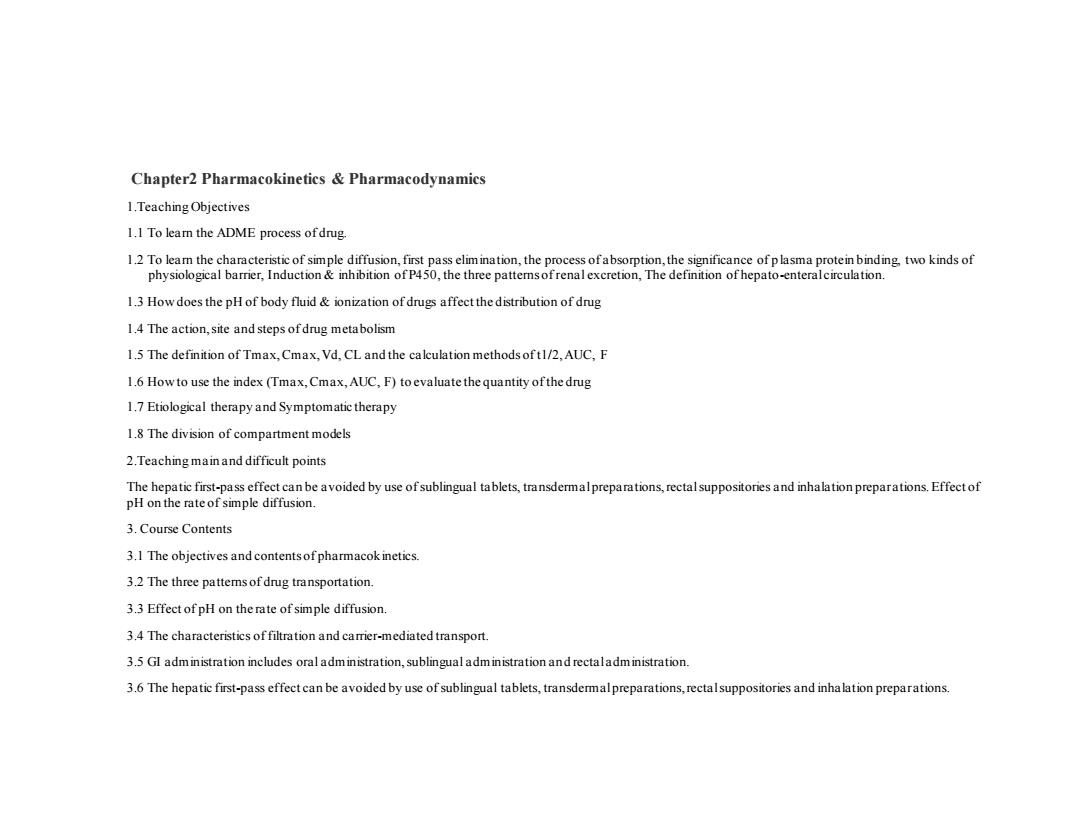正在加载图片...

Chapter2 Pharmacokinetics Pharmacodynamics 1.Teaching Objectives 1.1 To learn the ADME process ofdrug. 1.2 To leam the characteristic of simple diffusion,first pass elimination,the process ofabsorption,the significance ofp lasma protein binding,two kinds of physiological barrier,Induction inhibition of P450,the three patternsofrenal excretion,The definition of hepato-enteralcirculation. 1.3 How does the pH of body fluid ionization of drugs affect the distribution of drug 1.4 The action,site and steps of drug metabolism 1.5 The definition of Tmax,Cmax,Vd,CL and the calculation methods oft1/2,AUC,F 1.6 How to use the index (Tmax,Cmax,AUC,F)to evaluate the quantity ofthe drug 1.7 Etiological therapy and Symptomatic therapy 1.8 The division of compartment models 2.Teaching main and difficult points The hepatic first-pass effect can be avoided by use of sublingual tablets,transdermalpreparations,rectal suppositories and inhalation preparations.Effect of pH on the rate of simple diffusion. 3.Course Contents 3.1 The objectives and contents of pharmacok inetics. 3.2 The three patterns of drug transportation. 3.3 Effect of pH on the rate of simple diffusion. 3.4 The characteristics of filtration and carrier-mediated transport. 3.5 GI administration includes oral administration,sublingual adm inistration and rectaladministration. 3.6 The hepatic first-pass effect can be avoided by use of sublingual tablets,transdermalpreparations,rectalsuppositories and inhalation preparationsChapter2 Pharmacokinetics & Pharmacodynamics 1.Teaching Objectives 1.1 To learn the ADME process of drug. 1.2 To learn the characteristic of simple diffusion, first pass elimination, the process of absorption, the significance of p lasma protein binding, two kinds of physiological barrier, Induction & inhibition of P450, the three patterns of renal excretion, The definition of hepato-enteral circulation. 1.3 How does the pH of body fluid & ionization of drugs affect the distribution of drug 1.4 The action, site and steps of drug metabolism 1.5 The definition of Tmax, Cmax, Vd, CL and the calculation methods of t1/2, AUC, F 1.6 How to use the index (Tmax, Cmax, AUC, F) to evaluate the quantity of the drug 1.7 Etiological therapy and Symptomatic therapy 1.8 The division of compartment models 2.Teaching main and difficult points The hepatic first-pass effect can be avoided by use of sublingual tablets, transdermal preparations, rectal suppositories and inhalation preparations. Effect of pH on the rate of simple diffusion. 3. Course Contents 3.1 The objectives and contents of pharmacokinetics. 3.2 The three patterns of drug transportation. 3.3 Effect of pH on the rate of simple diffusion. 3.4 The characteristics of filtration and carrier-mediated transport. 3.5 GI administration includes oral administration, sublingual administration and rectal administration. 3.6 The hepatic first-pass effect can be avoided by use of sublingual tablets, transdermal preparations, rectal suppositories and inhalation preparations